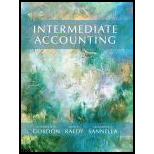
Intermediate Accounting
1st Edition
ISBN: 9780132162302
Author: Elizabeth A. Gordon, Jana S. Raedy, Alexander J. Sannella
Publisher: PEARSON
expand_more
expand_more
format_list_bulleted
Textbook Question
Chapter 7, Problem 7.5Q
Can an ordinary annuity table be used to determine the present value of a three-year investment that pays $100 in the first year, $150 in the second, and $200 in the last year of the contract? Explain.
Expert Solution & Answer
Want to see the full answer?
Check out a sample textbook solution
Students have asked these similar questions
Please provide the correct answer to this general accounting problem using accurate calculations.
Can you help me solve this general accounting problem using the correct accounting process?
Can you explain the correct approach to solve this financial accounting question?
Chapter 7 Solutions
Intermediate Accounting
Ch. 7 - Prob. 7.1QCh. 7 - Prob. 7.2QCh. 7 - If interest is compounded more than once a year,...Ch. 7 - Prob. 7.4QCh. 7 - Can an ordinary annuity table be used to determine...Ch. 7 - Prob. 7.6QCh. 7 - Is the present value of an ordinary annuity more...Ch. 7 - Prob. 7.8QCh. 7 - Simple Interest. Assume Shafer Corporation...Ch. 7 - Compound Interest. Assume Shafer Corporation...
Ch. 7 - Prob. 7.3BECh. 7 - Prob. 7.4BECh. 7 - Prob. 7.5BECh. 7 - Present Value of a Single Sum, Compound Interest....Ch. 7 - Future Value of a Single Sum, Compound Interest....Ch. 7 - Prob. 7.8BECh. 7 - Present Value of a Single Sum, Compounded Interest...Ch. 7 - Prob. 7.10BECh. 7 - Present Value of a Single Sum, Calculating Time...Ch. 7 - Future Value of an Ordinary Annuity. An...Ch. 7 - Future Value of an Annuity Due. Mariah Carey...Ch. 7 - Future Value of an Ordinary Annuity: Calculating...Ch. 7 - Present Value of an Ordinary Annuity. CB...Ch. 7 - Present Value of an Annuity Due, Semiannual...Ch. 7 - Prob. 7.17BECh. 7 - Ordinary Annuity, Annuity Due, Using Interest...Ch. 7 - Prob. 7.2ECh. 7 - Prob. 7.3ECh. 7 - Prob. 7.4ECh. 7 - Prob. 7.5ECh. 7 - Prob. 7.6ECh. 7 - Prob. 7.7ECh. 7 - Future Value of an Ordinary Annuity, Future Value...Ch. 7 - Single Sum, Solving for Other Variables. Two...Ch. 7 - Ordinary Annuity, Solve for Interest Rate,...Ch. 7 - Present Value, Note Payable Prices. Wiz Khalifa...Ch. 7 - Future Value of a Deterred Annuity. Lenny Shafer...Ch. 7 - Prob. 7.13ECh. 7 - Present Value of an Ordinary Annuity, Present...Ch. 7 - Prob. 7.15ECh. 7 - Prob. 7.16ECh. 7 - Future Value of an Annuity Due, Decision Making....Ch. 7 - Prob. 7.18ECh. 7 - Prob. 7.19ECh. 7 - Prob. 7.20ECh. 7 - Prob. 7.21ECh. 7 - Prob. 7.22ECh. 7 - Prob. 7.1PCh. 7 - Present Value, Present Value of an Ordinary...Ch. 7 - Present Value, Present Value of an Annuity Due,...Ch. 7 - Prob. 7.4PCh. 7 - Prob. 7.5PCh. 7 - Prob. 7.6PCh. 7 - Prob. 7.7PCh. 7 - Present Value of an Annuity Due, Deferred...Ch. 7 - Present Value of an Ordinary Annuity, Present...Ch. 7 - Future Value of an Ordinary Annuity, Deferred...Ch. 7 - Present Value, Present Value of an Ordinary...Ch. 7 - Prob. 7.12PCh. 7 - Prob. 7.13PCh. 7 - Expected Cash Flows. Hiteck Electronics sells a...Ch. 7 - Prob. 7.15P
Knowledge Booster
Learn more about
Need a deep-dive on the concept behind this application? Look no further. Learn more about this topic, accounting and related others by exploring similar questions and additional content below.Similar questions
- I need help with this general accounting question using the proper accounting approach.arrow_forwardPlease explain the solution to this general accounting problem with accurate explanations.arrow_forwardI need guidance with this general accounting problem using the right accounting principles.arrow_forward
- Please provide the answer to this general accounting question with proper steps.arrow_forwardCan you explain the correct methodology to solve this general accounting problem?arrow_forwardI am trying to find the accurate solution to this general accounting problem with appropriate explanations.arrow_forward
arrow_back_ios
SEE MORE QUESTIONS
arrow_forward_ios
Recommended textbooks for you
 Intermediate Accounting: Reporting And AnalysisAccountingISBN:9781337788281Author:James M. Wahlen, Jefferson P. Jones, Donald PagachPublisher:Cengage Learning
Intermediate Accounting: Reporting And AnalysisAccountingISBN:9781337788281Author:James M. Wahlen, Jefferson P. Jones, Donald PagachPublisher:Cengage Learning

Intermediate Accounting: Reporting And Analysis
Accounting
ISBN:9781337788281
Author:James M. Wahlen, Jefferson P. Jones, Donald Pagach
Publisher:Cengage Learning
What is an Annuity? Are Annuities a Good Investment? Basics of an Annuity, a Whiteboard Animation; Author: Learn to invest;https://www.youtube.com/watch?v=Wq7nq8Gx78w;License: Standard YouTube License, CC-BY